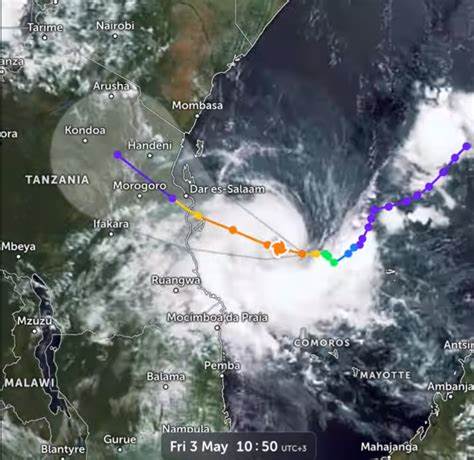Kenyan Coast still on high alert as Cyclone Hidaya dissipates
By Reuben.Mwambingu and Ronald Mwadzombo, May 6, 2024Kenyan Coast remains on high alert despite latest reports indicating that Tropical Cyclone Hidaya, initially predicted to strike the region over the weekend, has weakened and dissipated.
The Kenya Meteorological Department, monitoring developments off the Tanzanian coast following Cyclone Hidaya’s landfall in the neighbouring country, stated that heavy rains will continue along the coastal region due to the cyclone.
“The Tropical Cyclone Hidaya storm is over and forecasted to have weakened, however heavy rainfall is still expected offshore along the Coast region with strong winds and large waves already experienced in Kwale,” the agency noted.
For the better part of the weekend the Coastal counties of Mombasa, Kwale, Kilifi, and Lamu remained on high alert, with authorities cautioning the general public including the fisherfolk and beach operators to keep off the shores for the next couple of weeks until it is “the Coast is clear” from the effects of cyclone Hidaya.
Crisis meeting
Mombasa Governor Abdulswamad Nassir who convened a crisis meeting with the security apparatus and the disaster management teams announced the suspension of all construction, quarrying and all activities in the public and private beaches, saying that people living near the shoreline will be evacuated.
“Everyone is in tension and fear because we have received reports that the cyclone has passed Pemba and has landed in Dar es Salaam. Preliminary data has shown that impacts of the cyclone could be even more devastating and highly destructive than the cyclone itself. This is why we need to take precautions,” said Nassir.
His Kwale counterpart Fatuma Achani also asked residents to take the warning seriously.
“We have talked to Beach Management Units on the expected cyclone and we have agreed with them not to extend their fishing activities in the deep sea to avoid being swept away by strong waves,” said Achani, adding that she has set up a team to monitor the situation in the next seven days.
The alert came as fisher folk at the Coast decry huge losses saying that even before the warning, strong winds that started blowing along the shores since last week had already denied them access to high-value fishing points in the high seas.
“Fishing has been so challenging since the winds began blowing last week. The sea has been extremely rough and the ocean has been dark and cloudy, so vision has not been clear…Actually it is risky going deeper into the high seas because unfortunately our equipment is inferior and cannot maneuver through strong winds,” said Famawy Mohamed, a fisherman at Nyali Pirates beach.
Keep off ocean
Kilifi county government has also issued an alert to fishermen to keep off the Indian Ocean.
Led by Kilifi county government chief officer for Disaster management Irene Opicho, the government pronounced that they were going to give foodstuff to the affected fishermen to caution them from hunger.
Opicho said they have already distributed them with bags of rice and beans for a start-up and were on plans to make more arrangements to ensure they are taken care of before the tide subsides.
She however said they were going to set daily patrol boats in the ocean and enhance offshore patrols to ensure no fisherman ventures into the ocean.
Kennedy Nyale coordinating Kilifi beach management Units said the cyclone has affected over 50,000 people both fishermen and people dependent on the product.
Nyale said they are adversely affected but assured to abide by the laid down regulations and go by the alert to ensure fishermen were safe. Fishmongers from Kilifi also expressed their disappointment calling upon the government to allocate disaster funds for affected people in the fishing industry.
More Articles

